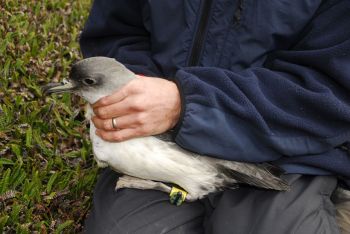Sub-Antarctic Marion Island in the southern Indian Ocean belongs to South Africa. It has been the site of ornithological research on seabirds, including ACAP-listed albatrosses and petrels, for over half a century.
The following text is taken from the last issue of the popular magazine Africa Birds & Birding, with permission of the author and editor.
"Marion Island, the larger of the two Prince Edward Islands, lies in the heart of the Roaring Forties, more than 2 000 kilometres from South Africa. A feral cat population became entrenched on the island after a few pets were taken to control house mice at the weather station that was established after South Africa annexed the islands in 1948. The mice were themselves introduced by sealers who visited the island in the 19th century. Unfortunately, the cats preferred to eat the island's native birds, especially the burrow-nesting petrels, and by the 1970s more than 2 000 cats were killing some 450 000 petrels each year. As a result, at least one species, the Common Diving Petrel, disappeared from the island and all the other petrels became far less common than at predator-free Prince Edward Island. A decade-long programme led by Marthan Bester finally succeeded in eradicating cats from the island in 1991. At 295 square kilometres, Marion remains the largest island from which cats have been removed. With the cats gone, petrel populations should have recovered; 20 years is long enough for their populations to increase three- to four-fold simply through natural growth. And growth rates can be much faster when there are adjacent populations that act as a source of immigrants, as is the case at Marion, with Prince Edward only 19 kilometres away. Initial signs were positive and petrel breeding success did increase immediately after the cats were eradicated. However, the extent to which their populations have recovered is unknown, and evidence from Subantarctic Skuas is not encouraging. Whereas skuas breeding on Prince Edward Island prey mainly on petrels, the diet of those on Marion is dominated by penguin eggs and chicks. This diet hasn't changed over the past two decades, and skua numbers have almost halved at Marion Island during this period. There is a baseline estimate of petrel numbers on Marion Island. Mike Schramm counted burrows in a range of habitats in the northeastern part of the island in 1979-80. But surveying burrowing petrel nests is not the most objective of techniques. Fortunately, we were able to entice Mike back to Marion in April-May 2012 to help set up the new project. His experience and insights proved invaluable to Ben Dilley, the student tackling the current survey. Ben will repeat Mike's surveys during the coming year to see whether petrel numbers have recovered. He will also estimate the breeding success of selected species and place cameras in the nests of some species to see whether there are any untoward visitors. Our fear is that mice are attacking petrel chicks, as they do on Gough Island. Mike reports that the biggest change he noticed on his return to Marion was the dramatic increase in mouse densities. And given attacks on Wandering and Sooty albatross chicks on Marion in the past few years, it seems likely that mice are indeed attacking burrowing petrel chicks. Ben's project should tell us how severe a problem they pose and give us some idea of how much petrel populations have benefited from the removal of cats from Marion Island."

A Grey Petrel at Marion Island gets a leg-mounted logger
Photograph by Ben Dilley
In contrast ACAP-listed Grey Petrels Procellaria cinerea (and other burrowing species) appear to be doing well on Australia's Macquarie Island in the absence of cats and (it is hoped) rodents and rabbits following eradication efforts in the last few years (click here).
For earlier news of research on Marion Island's Grey Petrels click here.
Reference:
Percy FitzPatrick Institute 2012. New project to assess petrel status. Africa Birds & Birding 17(4): 16.
With thanks to Leni Martin and Peter Ryan.
John Cooper, ACAP Information Officer, 19 October 2012

 English
English  Français
Français  Español
Español